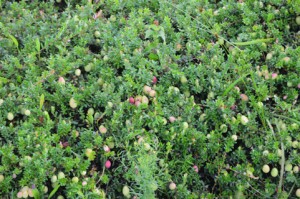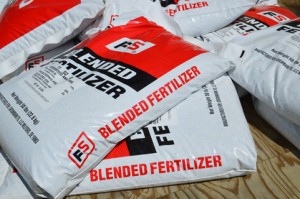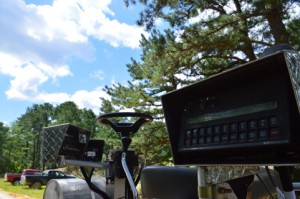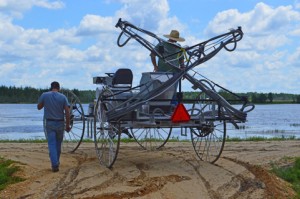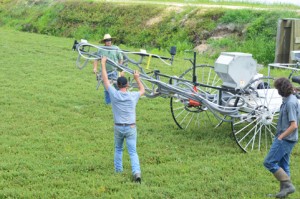While the busiest part of the growing season is behind us, our Integrated Crop Management program is still working on our last fertilizer applications before harvest begins next month. The amount of fertilizer to be applied is determined by variety, soil conditions, and past practices, requiring constant evaluation of current conditions, history, and trends. Nutritional needs are also different for young vines as opposed to established plantings.
Additional nutrition is necessary because while cranberries have adapted (and thrive) in their native sandy soil, nutrients are taken from the bog through the harvest of fruit. The three main elements usually added for nutrition are nitrogen, phosphorus, and potassium. According to cranberries.org: “Cranberry plant demand for nitrogen is highest during three stages of the lifecycle critical to cranberry development–early growth, fruit set and bud set. Early growth is when the plant grows vegetatively through vining and root growth and produces a flush of new leaves. Fruit set is when the flower becomes pollinated and fruit begin to form. Soon after fruit set comes bud set when nitrogen is needed for both fruit development and production of the next year’s flower bud.”
“For the established beds, we’re doing a final application to make sure the plants have enough nutrition to stay healthy and set buds for next year’s crop,” says manager Mike Haines. “For the Early Blacks, we’re doing one more application, but the Stevens are getting at least two more. And the young beds will be treated for a little longer than that.” We rely on on stalwart vendors such as Downstown Aero for broad application, but for precision application our team is working with some new equipment!
COO Bryan vonHahmann refers to this machine as the “fertilizer buggy”, and it’s not hard to see why. As so many things in the cranberry industry do, the initial idea came from a chat with a neighboring grower. “It all started from wanting to get more accurate applications,” he says. “Bill Cutts brought his over for us to look at. Kevin Sooy [another neighbor] built the frame for us. His family has one, the Lees have one; all of them have hopper spreaders, and we decided we wanted something even more precise. So we added an air system with individual nozzles. It’s going well! We bought a computer to calibrate different products: liquid, dry, different fertilizers. We have a few tweaks to make yet but over time we’ll probably end up with another one here and one in Chile.”
Team members have been pleased with the results. “I like the area you can cover with it,” says Jeremy Fenstermaker. “Once you get it calibrated you don’t have to mess with it; it’s all computerized. We go by by weight; just enter the numbers for each different product and it’s dispensed at the correct rate. It’s always good to have another option. At first I didn’t think we needed it, but it’s been very useful. Much better than out there with a bucket! That 40 foot boom makes a huge difference. And it shouldn’t be too hard on the plants; you can barely see where it drove through the bog, with those tires.”
And, of course, we’re always looking ahead. “This is going to improve our overall efficiency,” Mike says. “We’ll be able to free up a couple of people to fill in elsewhere but still get a lot of ground covered.”

